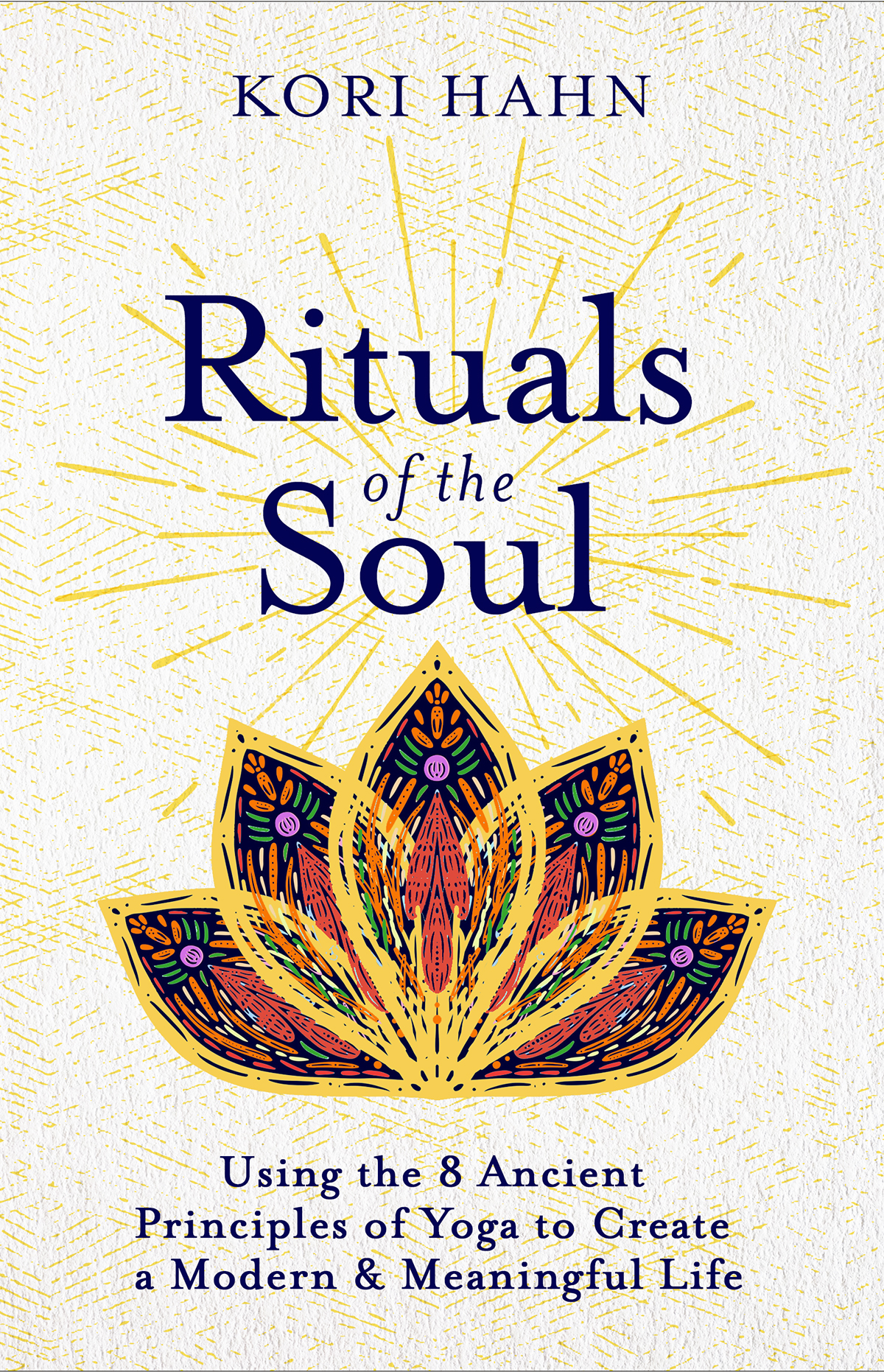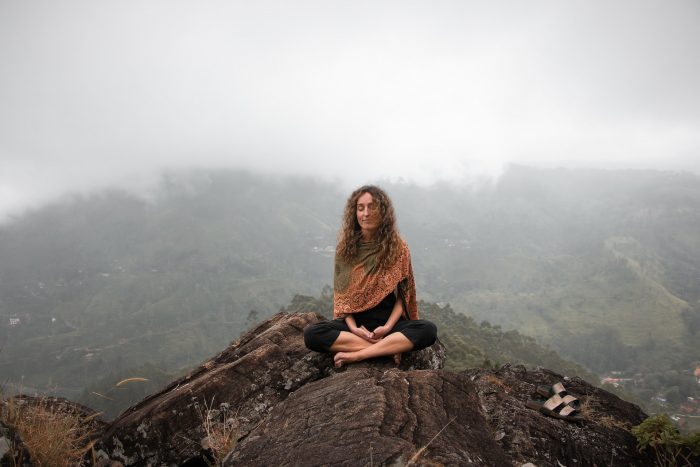An Excerpt from Rituals of the Soul by Kori Hahn
~
When you understand how something works, you are more likely to use it.
To better understand mindful meditation, imagine that your mind is an attic filled with boxes stuffed with memories, experiences, and feelings. To truly comprehend the dimensions of the attic, you must clear out the boxes or at least organize and move things around a little bit. Meditation is the light bulb allowing you to see what is in the attic. You will be amazed at what you have been storing in there.
The mind is made up of three different components: awareness or consciousness (the light bulb); the thinking mind (the attic); and the memories and feelings (the clutter of boxes in the attic). When you meditate, your heightened awareness may bring to light the voices cluttering your mind and never-before-felt sensations on the skin of your body. Meditating isn’t always going to feel peaceful and calming; you may experience anger, sadness, frustration, jealousy, or guilt. Traumatic events or distant memories may resurface. You may, for example, have a resurgence of memories of someone who is no longer with you, and that may bring you both joy and sadness.
As you move through waves of emotions, seeing all the memories that live within your mind, you transition into your natural state of being, open and expansive. You clean the attic. In the same way that we discussed creating space in your body earlier, you develop mindfulness by creating space in the mind.
People often tell me that they do not have the time to meditate. But even if you’re a busy person, you can find some way to bring mindfulness into every waking hour of your life. You don’t have to breathe like the quintessential cross-legged yogi on a cushion in order to meditate; you can bring awareness to your breath any time of the day, while doing anything.
When you first begin meditating, I suggest committing to a certain amount of time to familiarize yourself with the practice and ensure you create a healthy habit. Set a timer, even if it’s just for five minutes in the beginning, and then add a minute each day. It’s best if you can work up to trying the different practices below for at least fifteen minutes each. If something feels good to you, keep it in mind for your own mindful rituals. This is how you find what works best for you: by feeling your way to the practices that resonate with you most.
Just within the two types of breathing techniques I describe here, there are hundreds of variations to play with. What follows are the foundational practices, but if you know other breathing practices that work for you, by all means consider using those when creating your rituals.
Meditation Posture: Padmasana
When you meditate, it’s preferable to sit up rather than lie down because it keeps the mind more alert; you’ll be less inclined to fall asleep. Therefore, start in a seated position that feels comfortable and steady. Place cushions beneath your hips or your knees if this helps, or sit in a chair or even on the edge of your bed or couch if that feels better for you. When you take a similar posture every time you meditate, your muscle memory will help you transition more easily into a meditative state each time.
The classic yogi meditation posture is called Padmasana, or Lotus position. This is often how the Buddha is depicted in temples and paintings. Simply sit on the floor with your legs crossed, either fully crossed in the Lotus position or loosely crossed, whichever is most comfortable for you. From this position, begin lifting your posture from the crown of the head, growing a tall, long spine. Allow the tailbone to ground itself in the opposite direction of your head while you inhale and lengthen through the spine. Soon, you will be able to exhale, soften, and relax into this position without trying.
Tuck your chin toward your chest just a little, giving your spine more freedom. Lightly press the tip of the tongue against the roof of your mouth just behind your upper row of teeth. Roll your shoulders back and down, finding a neutral posture. Now, mentally scan through the body, and if you notice tension, make subtle movements to help you feel more comfortable. Place your hands in your lap with your left hand on top, palm facing upward.
While this is the most common meditation pose, you can meditate in any position. If you find this posture difficult, simply sit in a chair or on the couch with a straight spine to keep you alert. The most important thing is to make sure that you are comfortable and the body feels soft. Ultimately, you are training yourself to meditate in all positions, while walking, talking, and moving about your life, so feel free to experiment with different postures and then stick with the one that feels the most steady and comfortable to you.
The Meditative Natural Breathing Practices
The first breathing technique I will teach you is meditative natural breathing, the basic introduction to meditation. Simply by watching your breath as it moves in and out of the nose, you are training your mind to focus. Here are two versions of the practice.
The Mindfulness of Breathing Practice
The first meditation I ever learned is called anapanasati, or “mindfulness of breathing.” This meditation was originally taught by the Buddha himself and has since been adopted by Tibetan, Zen, Tiantai, Theravada, and Western meditation schools. Nearly every style of meditation around the world begins with this practice, which is based on focusing your concentration on the sensations around the nostrils.
In a comfortable meditation position (whatever that looks like for you), close your eyes and bring your awareness to the tip of your nose. Feel the breath move in and out of the body without changing your breathing in any way.
Let the breath flow in its own natural rhythm, and just observe it.
As the mind wanders, which it will, compassionately and patiently refocus your awareness back on the nostrils and the upper lip. When the mind drifts off to thoughts, this does not mean that you have failed or had a “bad” session. Distractions are opportunities for retraining the mind to become more mindful.
The Zen Breath Counting Practice
In the Zen Buddhist tradition, the Zen breath counting meditation practice is taught to first-time meditators as a technique for increasing your ability to concentrate by giving you a subtle action to focus on: in this case, counting the breath.
Begin by taking a deep breath in, silently say, “One,” and then exhale, silently saying, “One” again. Slowly and softly inhale, mentally say, “Two,” and then exhale, mentally saying, “Two.” Continue breathing like this, counting each breath until you reach ten. Then work your way backward down to one. When you lose track of what number you last said, which you inevitably will, simply begin again at one.
Many of us lose our focus; even lifelong monks have some days when they are more unfocused than others. Try not to become tense or frustrated as this happens; calmly continue counting as the breath naturally moves in and out. If you are doing the practice, you are developing mindfulness, which means you are learning to focus and live in the present moment.
If you confidently count up to ten and back a few times in a row, then make it a little more challenging and increase your counting to twenty. Buddhist masters have claimed that when you can consciously breathe up to one hundred and back down to one again, you will have developed such inner power that you’ll be able to achieve anything in life you set your mind to. In other words, you are developing your ability to create your own reality.
Zen breath counting is one of the best practices for beginners because you can actually watch your mind growing more mindful as your ability to increase the count improves. At first, you may be able to stay focused on your breath only up to the count of four, but a few days later you may find yourself staying focused up to the count of twenty or thirty. Every day is different, every moment is different, and the number you can count to on any given day will differ.
Rather than look at this practice as something you are improving, try to look at it as an exploration of where your ability to concentrate is in this exact moment, without any judgments or labels.
~
Excerpted from the book from Rituals of the Soul. Copyright ©2021 by Kori Hahn. Printed with permission from New World Library.
~












Read 3 comments and reply